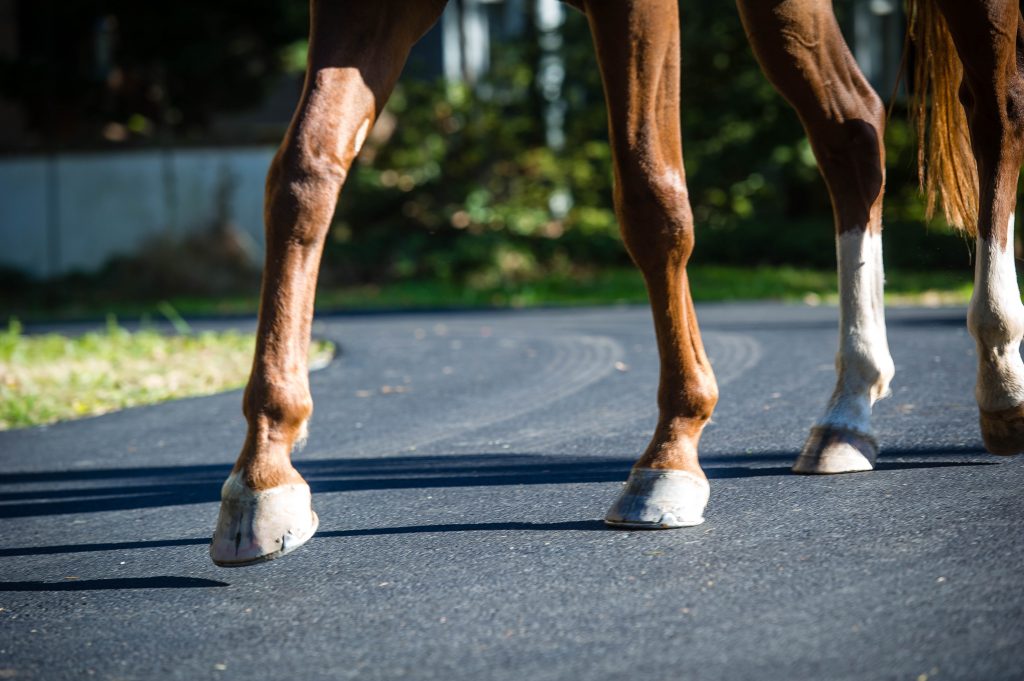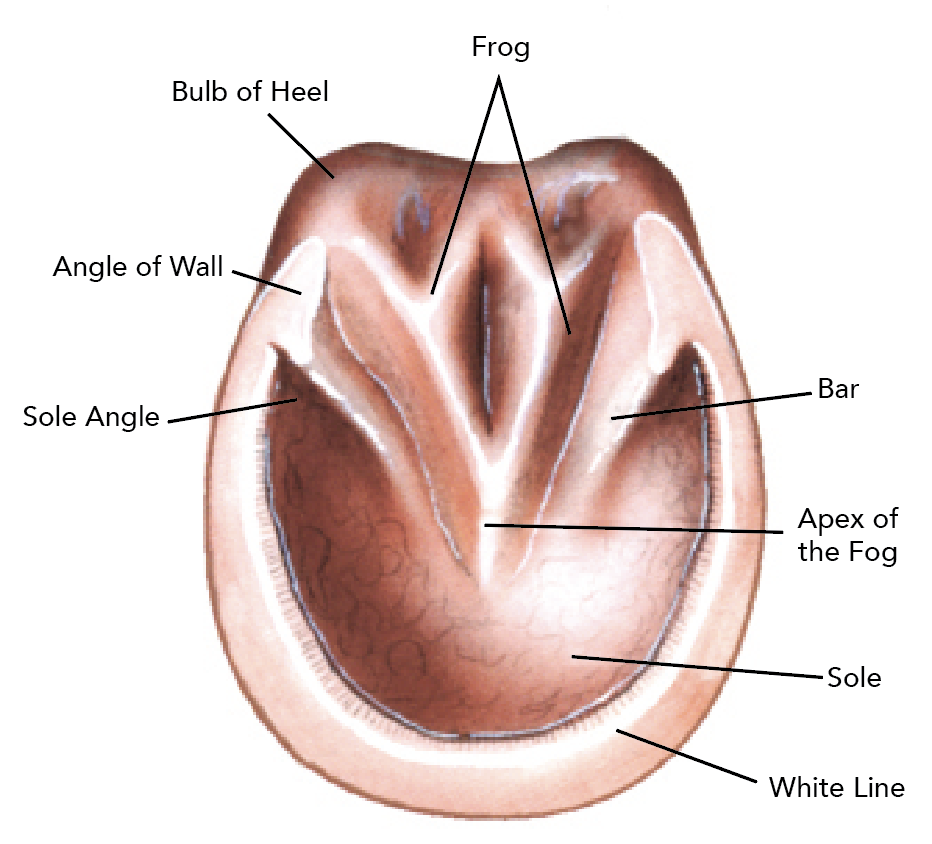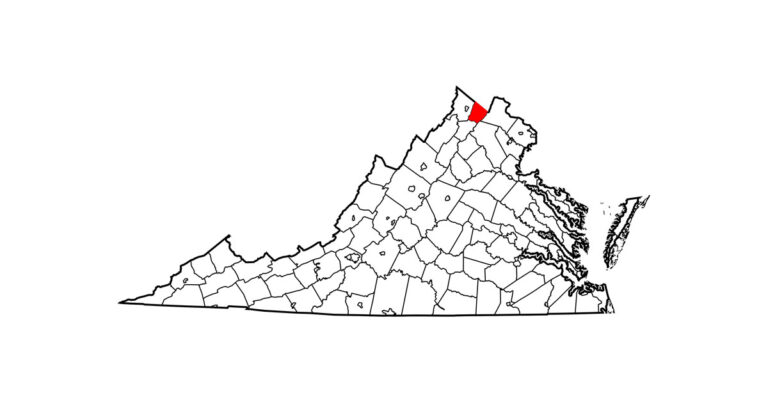Keeping your horse’s hooves in tip-top condition can be difficult during the summer. No matter how diligent your approach to care, it’s easy to get tripped up by the one factor over which you have no control: the weather. Moisture, in particular, can have mild to dramatic effects on even healthy hooves as it varies from season to season, within a season and geographically. That said, it is possible for you to help your horse take the challenges of summer weather in stride. Here’s how.

© Amy K. Dragoo
Aim for the Ideal
In general, a healthy hoof has these basic qualities:
- a wall that is smooth, uniform and naturally glossy, marked with fine, faint vertical stripes formed by tubules of horn. These elongated cylindrical structures, composed of the fibrous protein keratin (also a component of hair, skin and nails), provide strength and density to the wall and allow it to be porous and maintain a certain desirable amount of flexibility.
- a rubbery, resilient frog
- strong bars and heels
- a scooped-out (concave) sole that protects the most sensitive parts of the hoof and serves as a shock absorber.
Moisture’s Ill Effects
The structures that normally make a hoof strong and resilient are especially susceptible to the effects of excessive moisture in the environment. Porous in nature, the hoof absorbs wetness like a sponge, which can weaken the connective tissues that hold the horn tubules in place. This causes the wall to expand and stretch out of shape. The sole may then drop under the horse’s weight. This “pancaking” can cause the wall to weaken further, crack, split or chip. And that makes it easy for bacteria and foreign material to penetrate the hoof capsule, which includes the hoof wall, sole, frog and the bulbs of the heel. This can invite the formation of abscesses and endanger the integrity of other structures within, such as the coffin bone. A weakened hoof is also susceptible to
- thrush—a foul-smelling degeneration of the frog caused by bacteria
- white line disease—a mixed bacterial and fungal condition that originates
- on the bottom of the hoof and progresses upward
- coronitis—inflammation of the coronary band at the top of the hoof, caused by bacteria and other organisms
- scratches—a scabby or oozing skin infection above the heels that can
- cause lameness.
A weakened hoof wall is also less able to retain a shoe. Clinched nails will more easily loosen, pull out or tear away. Any loss of wall makes it more difficult for a farrier to reset the shoe.

Courtesy, Illustrated Atlas of Clinical Equine Anatomy and Common Disorders of the Horse
What You Can Do
To prevent excess moisture in the environment from harming your horse’s hooves:
Know how they grow. During the darkest days of winter your horse’s hooves grow at their slowest rate of the year. An increase in daylight as spring approaches triggers the production of hormones that cause the hooves to experience a growth spurt. The usual rate is approximately one-quarter to three-eighths of an inch per month, with young horses’ hooves growing faster than those of older horses.
Schedule the farrier based on need. On average, that means every six to eight weeks, but as often as necessary, depending on how fast your horse’s hooves are growing. That could be every four weeks in the spring and at a slightly longer interval in summer.
Apply a hoof sealant. It will condition and toughen the foot while maintaining the wall’s natural moisture. It should also strengthen hooves that already are mushy, shelly, brittle or cracked. Plus, it can provide a protective barrier against fugus, bacteria and caustics. For the best results, apply sealant to a clean, dry foot, according to package directions. Resist any urge to overdo. More won’t help your horse.
Look for ways to adapt. Limit the time your horse spends in wet, muddy conditions. Keep baths to a minimum to spare hooves from prolonged periods in puddles. Avoid extreme changes of footing as best you can. This may be difficult during the summer when horses typically go from dew-covered pastures in the morning to areas where the surface underfoot is more likely to be sunbaked by afternoon. Sudden changes in footing can also occur when a horse is trailered from one locale to another, whether the destination is a new trail a few miles down the road or the grounds of a competition several states away.
Rely on routine. A quick check of your horse’s hooves prior to turnout each day can reveal signs of trouble brewing: heat, cracks, abscesses, punctures and more. Picking out hooves before each ride allows you to check the condition of the sole. You may find yourself removing small stones and other objects that have become lodged. You’ll also become aware of risen clinches or whether the shoe has sprung or shifted and needs attention.
Feed wisely. Enlist your veterinarian to evaluate your horse’s ration and assist your efforts to provide a nutritionally sound diet. The addition of a supplement containing biotin (a B vitamin) may help to support hoof growth.
Keep him moving. Maintain a consistent exercise regimen, working your horse on a quality surface to increase growth-stimulating circulation to the hooves.
Use protective gear. Shipping bandages, bell boots and shipping boots all help to safeguard against hoof injuries during trailering.
Take care of trouble spots around the farm. Identify areas where drainage is poor and take steps to improve it, perhaps by installing French drains or putting down gravel. Direct rain off roofs with gutters. Reposition feed stations and water troughs if the footing in these spots where horses gather is showing signs of wear and tear. Keep stalls well bedded and clean.
Sultry summer weather may indeed present challenges to how you care for your horse’s hooves. But meeting them head-on can help your horse stay sound all season—and that’s good news for him and for you.
Thanks to farrier Steve Kraus for his technical assistance in the preparation of this article. A member of the International Farriers Hall of Fame, he is the head of Farrier Services in the Department of Clinical Sciences at the Cornell University College of Veterinary Medicine in Ithaca, New York. In his more than 50 years as a farrier, Kraus has shod horses of many breeds involved in a variety of activities. His extensive experience serves as the basis for his new book, Shoeing the Modern Horse: The Horse Owner’s Guide to Farriery and Hoofcare, due for release this fall from Trafalgar Square Books.
This article originally appeared in the Summer 2022 issue of Practical Horseman.










